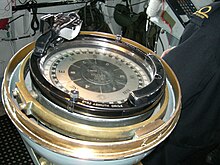User:Haus/8


Find sources: Google (books · news · scholar · free images · WP refs) · FENS · JSTOR · TWL
A telescopic alidade is a tool used for visual navigation aboard ships.
alidade. , n. The part of an optical measuring instrument comprising the optical system, indicator, vernier, etc. In modern practice the term is used principally in connection with a bearing circle fitted with a telescope to facilitate observation of bearings. Also called TELE- SCOPIC ALIDADE from http://www.nga.mil/MSISiteContent/StaticFiles/NAV_PUBS/APN/Gloss-1.pdf
bearing circle. . A ring designed to fit snugly over a compass or compass repeater, and provided with vanes for observing compass bearings. A similar ring provided with means for observing azimuths of the sun is called an AZIMUTH CIRCLE. ibid
gyrocompass. ,n. A compass having one or more gyroscopes as the direc- tive element, and which is north-seeking. Its operation depends upon four natural phenomena, namely gyroscopic inertia, gyro- scopic precession, the earth's rotation, and gravity. When such a compass controls remote indicators, called GYRO REPEATERS, it is called a master gyrocompass. See also DIRECTIONAL GYRO MODE. ibid
gyro repeater. . A device which displays at a different location the indi- cations of the master gyrocompass. See also COMPASS REPEATER ibid
bearing. , n. The horizontal direction of one terrestrial point from another, expressed as the angular distance from a reference direction. It is usually measured from 000° at the reference direction clockwise through 360°. The terms BEARING and AZIMUTH are sometimes used interchangeably, but in navigation the former customarily applies to terrestrial objects and the latter to the direction of a point on the celestial sphere from a point on the earth. A bearing is often designated as true, magnetic, compass, grid, or relative as the refer- ence direction is true, magnetic, compass, or grid north, or heading, respectively. The angular distance between a reference direction and the initial direction of a great circle through two terrestrial points is called great-circle bearing. The angular distance between a reference direction and the rhumb line through two terrestrial points is called rhumb or Mercator bearing. A bearing differing by 180°, or one measured in the opposite direction, from a given bearing is called a reciprocal bearing. The maximum or minimum bearing of a point for safe passage of an off-lying danger is called a danger bearing. A relative bearing of 045° or 315° is sometimes called a four-point bearing. Successive relative bearings (right or left) of 45° and 90° taken on a fixed object to obtain a running fix are often called bow and beam bearings. Two or more bearings used as intersecting lines of position for fixing the position of a craft are called cross bearings. The bearing of a radio transmitter from a receiver, as determined by a radio direction finder, is called a radio bearing. A bearing obtained by radar is called a radar bearing. A bearing obtained by visual observation is called a visual bearing. A constant bearing maintained while the distance between two craft is decreasing is called a collision bearing. See also CURVE OF EQUAL BEARING. ibid
prev. ref is bowditch


- QM 1&C man @ http://www.eric.ed.gov/PDFS/ED088693.pdf nr page 31 cross-fixes
- QM 3&2 man @ http://www.eric.ed.gov/PDFS/ED132263.pdf
- gyro, repeaters p 73
- TA, p 157-158
- P. 315 "a device used with a gyro repeater for taking bearings"
- http://www.vpul.upenn.edu/nrotc/ns301/lesson5.pdf lesson 5
- http://www.navsys.com/Papers/0409002.pdf p1, right col
- http://www.tpub.com/content/administration/14220/css/14220_85.htm much newer QM1&C w/pic
See also
[edit]References
[edit]- Bowditch, Nathaniel (2002). The American Practical Navigator. Bethesda, MD: National Imagery and Mapping Agency. ISBN 0939837544.
- Maloney, Elbert S. (December 2003). Chapman Piloting and Seamanship (64th ed.). New York, NY: Hearst Communications Inc. ISBN 1-58816-098-0.
{{cite book}}: Check|isbn=value: checksum (help)CS1 maint: date and year (link)
